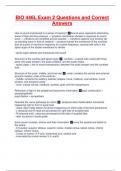Exam (elaborations)
BIO 446L Exam 2 Questions and Correct Answers
- Course
- Institution
How is sound transduced to a sense of hearing? Sound wave represents alternating areas of high and low pressure → tympanic membrane vibrates in response to sound wave → vibrations are amplified across ossicles → vibrations against oval window set up standing wave in fluid of vestibuli → pre...
[Show more]



